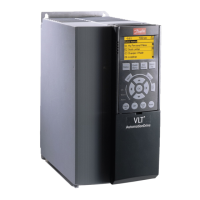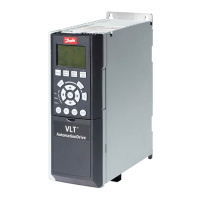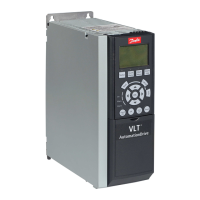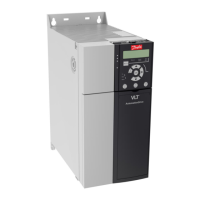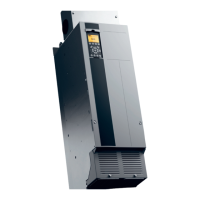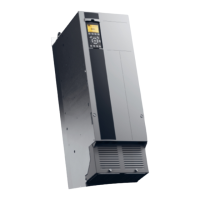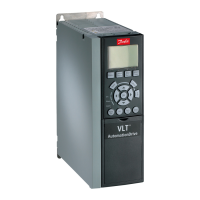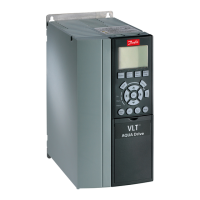Function Parameter Setting
Save the parameter setting to the LCP for safe keeping 0-50 LCP Copy [1] All to LCP
Table 3.6 Programming Order
3.4.2 Tuning PID Speed Control
The following tuning guidelines are relevant when using
one of the Flux motor control principles in applications
where the load is mainly inertial (with a low amount of
friction).
The value of 30-83 Speed PID Proportional Gain is
dependent on the combined inertia of the motor and load,
and the selected bandwidth can be calculated using the
following formula:
Par
. 7 − 02 =
Total
inertia
k gm
2
x
par
. 1 − 25
Par
. 1 − 20
x
9550
x
Bandwidth
rad
/
s
NOTE
1-20 Motor Power [kW] is the motor power in [kW] (i.e.
enter ‘4’ kW instead of ‘4000’ W in the formula).
A practical value for the Bandwith is 20 rad/s. Check the
result of the 30-83 Speed PID Proportional Gain calculation
against the following formula (not required if you are
using a high resolution feedback such as a SinCos
feedback):
Par
. 7 − 02
MAX
=
0.01
x
4
x
Encoder
Resolution
x
Par
. 7 − 06
2
x
π
x
Max
torque
ripple
%
The recommended start value for 7-06 Speed PID Lowpass
Filter Time is 5 ms (lower encoder resolution calls for a
higher filter value). Typically a Max Torque Ripple of 3 % is
acceptable. For incremental encoders the Encoder
Resolution is found in either 5-70 Term 32/33 Pulses Per
Revolution (24 V HTL on standard frequency converter) or
17-11 Resolution (PPR) (5V TTL on MCB102 Option).
Generally the practical maximum limit of 30-83 Speed PID
Proportional Gain is determined by the encoder resolution
and the feedback filter time but other factors in the
application might limit the 30-83 Speed PID Proportional
Gain to a lower value.
To minimize the overshoot,
7-03 Speed PID Integral Time
could be set to approx. 2.5 s (varies with the application).
7-04 Speed PID Differentiation Time should be set to 0 until
everything else is tuned. If necessary finish the tuning by
experimenting with small increments of this setting.
3.4.3 Process PID Control
The Process PID Control can be used to control application
parameters that can be measured by a sensor (i.e.
pressure, temperature, flow) and be affected by the
connected motor through a pump, fan or otherwise.
Table 3.7 shows the control configurations where the
Process Control is possible. When a Flux Vector motor
control principle is used, take care also to tune the Speed
Control PID parameters. Refer to the sections about the
Control Structure to see where the Speed Control is active.
1-00 Configu-
ration Mode
1-01 Motor Control Principle
U/f
VVC
plus
Flux
Sensorle
ss
Flux w/
enc. feedb
[3] Process Not
Active
Process Process
& Speed
Process &
Speed
Table 3.7 Control Configurations with Process Control
NOTE
The Process Control PID will work under the default
parameter setting, but tuning the parameters is highly
recommended to optimise the application control
performance. The two Flux motor control principles are
specially dependant on proper Speed Control PID tuning
(prior to tuning the Process Control PID) to yield their full
potential.
Introduction
VLT
®
AutomationDrive FC 300 Design Guide, 0.25-75 kW
MG33BE02 - VLT
®
is a registered Danfoss trademark 33
3
3
http://www.RSPSupply.com/p-21462-Danfoss-131B8966-VLT-Automation-VT-Drive-VFD-FC301-230V-5-HP.aspx

